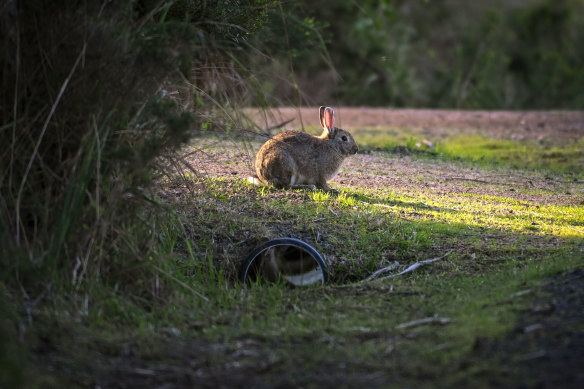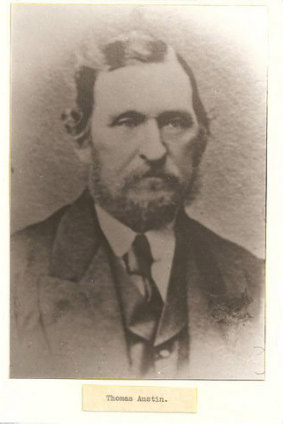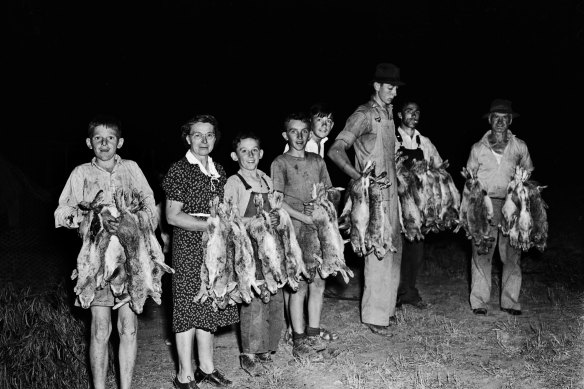How 24 rabbits took over Australia: DNA study confirms what caused invasion

DNA analysis has confirmed that just 24 wild English rabbits, let loose in western Victoria 163 years ago, triggered Australia’s most devastating biological invasion.
The study, led by the University of Cambridge and CIBIO Institute in Portugal, in collaboration with the University of NSW, revealed how rabbits took over Australia’s landscape.
A wild rabbit at Phillip Island.Credit:Eddie Jim
Rabbits were first introduced to Australia when five domestic animals were brought to Sydney on the First Fleet in 1788.
At least 90 more importations were made, but none became invasive until 1859 when Thomas Austin imported 24 wild rabbits from his family’s land in the west of England to his estate at Winchelsea near Geelong.
Within three years “Austin rabbits” had multiplied to thousands, and by the beginning of the 20th century the “grey blanket” had spread over the country at a rate of 100 kilometres a year – the fastest colonisation rate for an introduced mammal ever recorded.
The study findings, published in the journal Proceedings of the National Academy of Sciences, show invasive rabbits descended from Austin’s imports wreaked havoc across the continent.
Barwon Park in Winchelsea, Thomas Austin’s home where the rabbit plague began.
Study co-author Professor Mike Letnic from UNSW said scientists often lacked detailed information about where invasive animals came from.
“But in the case of wild rabbits in Australia, they are very well documented as one of the most successful biological invasions in the world,” he said.
Thomas Austin.
Research now showed a genetic pattern in Australia’s rabbit populations demonstrated that certain genetic types were predisposed to be successful invaders.
“It was the genetic makeup of a small batch of wild rabbits that ignited one of the most iconic biological invasions of all time,” lead author Joel Alves from the University of Oxford and CIBIO Institute said.
Researchers analysed historical records alongside new DNA collected from 187 European rabbits – mostly wild-caught across Australia, New Zealand, Britain and France between 1865 and 2018.
They found most mainland Australian rabbits derive from Austin’s 24 wild rabbits.
“We managed to trace the ancestry of Australia’s invasive population right back to the south-west of England, where Austin’s family collected the rabbits in 1859,” Alves said.
“Despite the numerous introductions across Australia, it was a single batch of English rabbits that triggered this devastating biological invasion, the effects of which are still being felt today.”
Australia’s rabbit plague in the early 1950s called for desperate measures.Credit:F.J. Halmarick
Rabbits introduced to Australia before 1859 were often described as tame, with fancy coat colours and floppy ears – traits associated with domestic breeds.
Austin rabbits were described as wild-caught and explains why they better adapted to local conditions, with changes in body shape to help control their temperature.
“So, it is possible that Thomas Austin’s wild rabbits, and their offspring, had a genetic advantage when it came to adapting to these conditions,” Alves said.
Despite rabbit-proof fences, the introduction of the deadly myxoma virus and other measures introduced to control populations, rabbits remain a major threat to native flora and fauna, costing the Australian agricultural sector an estimated $200 million a year.
The research also provides insights for managing invasive species.
“We need to be more careful that we always have appropriate quarantine measures ready to try to stop new biological invasions from occurring,” Letnic said.
Thomas Austin’s legacy stretches beyond the rabbits he brought to Australia. He was a founding father of horse racing in Victoria and The Austin Hospital at Heidelberg was established by the generosity of his widow, Elizabeth, in 1882.
Get to the heart of what’s happening with climate change and the environment. Our fortnightly Environment newsletter brings you the news, the issues and the solutions. Sign up here.
AP
Most Viewed in National
From our partners
Source: Read Full Article




